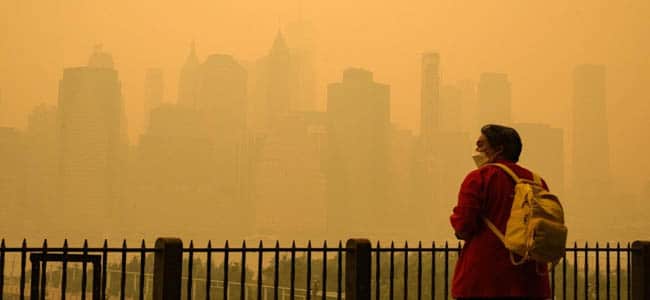
Exposure to fossil fuel air pollution significantly increases the risk of strokes, heart and lung disease, cancer and other ailments, causing more than 8.7 million premature deaths a year.
by Clara Chaisson
Natural Resources Defense Council
(February 19, 2021) If the consequences of burning fossil fuels—like melting glaciers, rising seas, and increasing global temperature averages—feel too far-flung or abstract, consider the fundamental act of taking a breath of air. A new study has found that air pollution from fossil fuels is responsible for nearly one in every five deaths worldwide.
Scientists have known for years about the deadly impacts of fossil fuel combustion, but a peer-reviewed study published in Environmental Research puts the global death toll at more than twice that of previous estimates. According to the research, exposure to fine particulate matter, or PM 2.5, from burning fossil fuels was responsible for about 8.7 million deaths globally in 2018. That’s roughly the same number of people living in New York City or London. Or, to put this health crisis into further perspective, fossil fuel pollution is not only fueling the climate crisis but it also kills more people each year than HIV, tuberculosis, and malaria combined.
“We don’t appreciate that air pollution is an invisible killer,” Neelu Tummala, an ear, nose, and throat physician at George Washington University School of Medicine and Health Sciences, told The Guardian. “The air we breathe impacts everyone’s health but particularly children, older individuals, those on low incomes, and people of color. Usually people in urban areas have the worst impacts.”
PM 2.5 is any airborne particle that is up to 2.5 microns in diameter—or about one-thirtieth the width of a single human hair. Particles this tiny are problematic because they linger in the air, are readily inhaled, and can penetrate deep into the lungs, where they can enter the bloodstream and inflict damage on multiple organs.
Links between this type of pollution and a wide range of serious health problems, such as cardiovascular disease, cancer, tissue damage, and asthma and other respiratory ailments are well documented. Inhaling high levels of PM 2.5 is especially dangerous for young children, whose organs and immune responses are still developing and who breathe in more air—and thus, more pollution—relative to their body weight than adults do. Exposure to air pollution has also been contributing to the disproportionate COVID-19 infection and death rates among people of color in the United States.
The recent Environmental Research study, authored by a team from Harvard University, the University of Birmingham, and the University of Leicester, is alarming for several reasons. The estimated 8.7 million premature deaths each year, for instance, don’t include those caused by long-term exposure to ozone air pollution, or smog, which is also driven by the combustion of fossil fuels. Its calculations for fatal lower-respiratory infections in children under five are also limited to higher-income countries in Europe and North and South America, where such cases tend to be much less common.
Overall, this type of pollution took the highest toll on people in China and India, totaling nearly five million premature deaths in those two countries alone. Other hard-hit areas included western Europe, Southeast Asia, and parts of the U.S. Northeast and Midwest.
In 2015, researchers for the Global Burden of Disease published what was described as “the most comprehensive worldwide observational epidemiological study to date”—which had calculated the annual PM 2.5 death toll at 4.2 million. Not only is that less than half the new estimate, but both the 2015 study and another recent global report looked at fine particulate pollution from all sources, while the latest research focuses solely on PM 2.5 pollution from burning fossil fuels.
Burning coal, gasoline, and diesel produces significant quantities of PM 2.5, including soot, but fine particulate matter can also come from natural sources like dust, wildfires, volcanoes, and sea spray. “We wanted to assess the health impact of fossil fuel–related PM 2.5, as these sources can be directly regulated,” says the study’s lead author, Karn Vohra, a doctoral candidate in environmental health and risk management at the University of Birmingham in England. “Other sources…are harder to control.”
Previous studies have relied on satellite and surface observations to estimate global PM 2.5 levels. In order to tease out the PM 2.5 from fossil fuel sources, the authors of the new study used GEOS-Chem, a global 3-D computer model of atmospheric chemistry powered by meteorological data from NASA’s Goddard Earth Observing System (or GEOS). They input regional fossil fuel emissions data from sources including industry, ships, aircraft, ground transportation, backup generators, kerosene, and oil and gas drilling. To validate their model, the scientists then checked their emissions data against on-the-ground observations from the World Health Organization.
Vohra says the team expected their expanded approach to yield higher mortality estimates. However, when it came to doubling the former estimates, he says, “We were surprised.”
Vohra and his coauthors attribute the higher death toll to their use of a much finer spatial scale when analyzing local measures of pollution. They also incorporated more recent data on the dangers of long-term exposure to PM 2.5 at low concentrations.
News that air pollution from fossil fuels kills one in five people is sobering to say the least, but as Vohra states, this is something we can actually change. And reining in these emissions can also make a big difference. For instance, China lowered its fossil fuel PM 2.5 emissions by about 44 percent between 2012 and 2018. Since doing so, the country has saved around 1.5 million lives each year.


